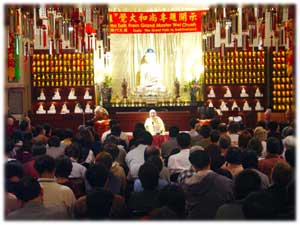 Ingredients:
Ingredients:
- Vegetarian ham
- Pickled vegetable
- Water chestnut
- Carrots
- Shiitake mushrooms
- Silken tofu
- Celery
- Ginger
Direction:
Cut tofu in half then in thirds. Lay them flat. Scoop out the middle. Sprinkle salt and cornstarch.
Mince the vegetarian ham, water chestnut, pickled vegetable, carrots and shiitake mushrooms. Sautee the minced shiitake mushrooms with minced ginger first. Blend the ingredients together along with salt, sugar, mushroom seasoning, cornstarch, sesame oil and the scooped out tofu.
 材料:
材料:
- 素火腿
- 榨菜
- 荸懠
- 紅蘿蔔
- 花菇
- 嫩豆腐
- 芹菜
- 薑
作法:
先將豆腐對切,再切成三份,每片分開放平後,將中間挖孔,灑上鹽及太白粉。 將花菇泡軟與
薑一起剁碎。另將素火腿,榨菜,荸懠,紅蘿蔔剁碎。剁碎食材混合後加調味料鹽,糖,磨菇精,
太白粉,芝麻油及挖出之豆腐塊拌勻。將內餡注入豆腐內,灑上太白粉後先蒸6分鐘左右,再放入熱
油中將豆腐兩面炸至金黃。水加芹菜勾芡做成醬汁,澆在豆腐上即可。




